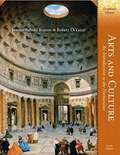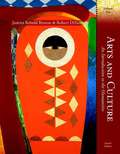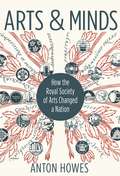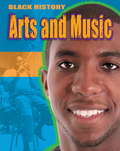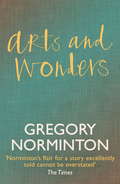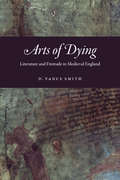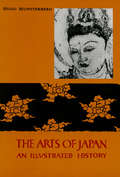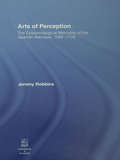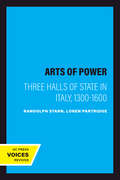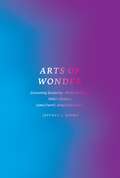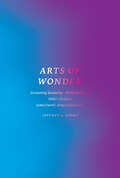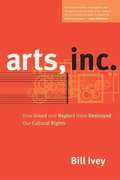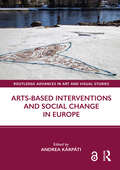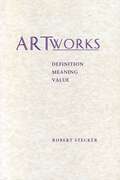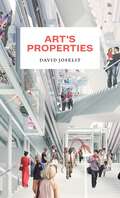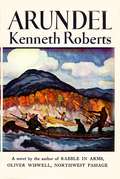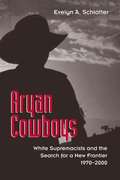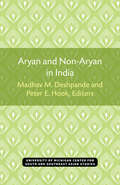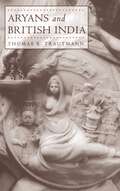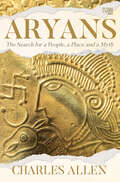- Table View
- List View
Arts & Ideas (7th edition)
by William FlemingIntended for courses in Western Humanities, this book chronologically explores the major styles as they appear in painting, sculpture, architecture, literature, music, and philosophy from antiquity to present using lively anecdotes.
Arts And Culture: An Introduction To The Humanities, Combined Volume
by Janetta Rebold Benton Robert DiYanniOffering an exploration of Western and World civilization's cultural heritage, this book is richly illustrated, beautifully designed and engaging.Readers move chronologically through major periods and stylesfrom prehistoric culture to 20th Century Americato gain insight into the achievements and ideas in painting, sculpture, architecture, literature, philosophy, religion, and music.For arts and cultural coordinators, professionals and enthusiasts.
Arts and Culture: An Introduction to the Humanities
by Robert Diyanni Janetta Rebold BentonFor one semester/quarter courses on Introduction to the Humanities or Cultural Studies. Now in full color, Arts and Culture provides an introduction to global civilizations and their artistic achievements, history, and cultures. The authors consider two important questions: What makes a work a masterpiece of its type? And what qualities of a work enable it to be appreciated over time? Critical thinking is also highlighted throughout the text with 4 different box features that ask students to explore connections across the humanities and different cultures. These boxes are entitled Connections, Cross Currents, Then & Now, and Cultural Impact boxes. Open the new fourth edition of Arts and Culture and open a world of discovery.
Arts and Culture: An Introduction to the Humanities, Volume I
by Janetta Rebold Benton Robert DiYanniFor one semester/quarter courses on Introduction to the Humanities or Cultural Studies. <p><p>Now in full color, Arts and Culture provides an introduction to global civilizations and their artistic achievements, history, and cultures. The authors consider two important questions: What makes a work a masterpiece of its type? And what qualities of a work enable it to be appreciated over time? Critical thinking is also highlighted throughout the text with 4 different box features that ask students to explore connections across the humanities and different cultures. These boxes are entitled Connections, Cross Currents, Then & Now, and Cultural Impact boxes. Open the new fourth edition of Arts and Culture and open a world of discovery.
Arts and Minds: How the Royal Society of Arts Changed a Nation
by Anton HowesA major new history of the extraordinary society that has touched all aspects of British lifeFrom its beginnings in a coffee house in the mid-eighteenth century, the Royal Society for the Encouragement of Arts, Manufactures and Commerce has tried to improve British life in every way imaginable. It has sought to influence how Britons work, how they are educated, the music they listen to, the food they eat, the items in their homes, and even how they remember their own history. Arts and Minds is the remarkable story of an institution unlike any other—a society for the improvement of everything and anything.Drawing on exclusive access to a wealth of rare papers and artefacts from the Society's own archives, Anton Howes shows how this vibrant and singularly ambitious organisation has evolved and adapted, constantly having to reinvent itself to keep in step with changing times. The Society has served as a platform for Victorian utilitarian reformers, purchased and restored an entire village, encouraged the planting of more than sixty million trees, and sought technological alternatives to child labour. But this is more than just a story about unusual public initiatives. It is an engaging and authoritative history of almost three centuries of social reform and competing visions of a better world—the Society's members have been drawn from across the political spectrum, including Adam Smith, Edmund Burke, and Karl Marx.Informative and entertaining, Arts and Minds reveals how a society of public-spirited individuals tried to make their country a better place, and draws vital lessons from their triumphs and failures for all would-be reformers today.
Arts and Music (Black History #2)
by Dan Lyndon-CohenWhether you enjoy listening to music, reading books and poetry, watching films or visiting art museums, the contributions made by artists and performers of African origin are all around you. Rising out of the shackles of slavery in centuries past, to increased recognition in this new century, it is clear that black people have made an enormous contribution to culture around the world. This book looks at the influences and key movements in the development of black artists and their work across the generations.The Black History series brings together a wide range of events and experiences from the past to promote knowledge and understanding of black culture today. This book looks at the influences and key movements in the development of black artists and their work across the generations.
Arts and Science at Toronto
by Craig BrownThe University of Toronto's Faculty of Arts and Science is older than the university itself. Chartered in 1827 as King's College, it officially opened in 1843 with four professors and twenty-seven students. In this lively and engaging book, Robert Craig Brown vividly recounts the 150-year history of the faculty's staff, students, and achievements.Brown takes readers on a sweeping journey though the development and growth of the faculty through wartime and peace, depression and prosperity. He covers teaching and research in the vast array of subjects offered, administrative and financial concerns, and the Faculty's significant contributions to higher education in Canada. Throughout, Brown traces how the faculty evolved past its early defining traits of elitism and exclusivity to its current form - a remarkably diverse body with students of all ages, backgrounds, and academic interests.
Arts and Wonders
by Gregory NormintonARTS AND WONDERS spans a glorious canvas, peopled by werewolves, thieves, emperors, travelling players and a forger dwarf who takes a lifetime to learn the danger of illusions.Tomasso Grilli, a dwarf gifted with an extraordinary capacity for artistic forgery (and flexible morals) recounts the story of his life, from his base beginnings in Florence, through his apprenticeship to the painter Arcimboldo, to his life of crime in Prague and subsequent banishment, to the gilded fame he finds as 'librarian' and collector to the court of an impoverished, ignorant ruler in the German Dukedom of Felsungrunde. Grilli's ambition and dubious skills take him to the pinnacle of success only for it to collapse beneath him like the illusion it always was. Betrayed and reviled he leaves Felsungrunde, is forced to join a group of travelling players, and finally learns the value of friendship. loyalty and honesty. The extraordinary cast of characters (some based on real historical figures) includes werewolves, an occult alchemist, a bear, a dodo, a lion and a maker of mechanical dolls.
Arts and Wonders
by Gregory NormintonARTS AND WONDERS spans a glorious canvas, peopled by werewolves, thieves, emperors, travelling players and a forger dwarf who takes a lifetime to learn the danger of illusions.Tomasso Grilli, a dwarf gifted with an extraordinary capacity for artistic forgery (and flexible morals) recounts the story of his life, from his base beginnings in Florence, through his apprenticeship to the painter Arcimboldo, to his life of crime in Prague and subsequent banishment, to the gilded fame he finds as 'librarian' and collector to the court of an impoverished, ignorant ruler in the German Dukedom of Felsungrunde. Grilli's ambition and dubious skills take him to the pinnacle of success only for it to collapse beneath him like the illusion it always was. Betrayed and reviled he leaves Felsungrunde, is forced to join a group of travelling players, and finally learns the value of friendship. loyalty and honesty. The extraordinary cast of characters (some based on real historical figures) includes werewolves, an occult alchemist, a bear, a dodo, a lion and a maker of mechanical dolls.
Arts of Dying: Literature and Finitude in Medieval England
by D. Vance SmithPeople in the Middle Ages had chantry chapels, mortuary rolls, the daily observance of the Office of the Dead, and even purgatory—but they were still unable to talk about death. Their inability wasn’t due to religion, but philosophy: saying someone is dead is nonsense, as the person no longer is. The one thing that can talk about something that is not, as D. Vance Smith shows in this innovative, provocative book, is literature. Covering the emergence of English literature from the Old English to the late medieval periods, Arts of Dying argues that the problem of how to designate death produced a long tradition of literature about dying, which continues in the work of Heidegger, Blanchot, and Gillian Rose. Philosophy’s attempt to designate death’s impossibility is part of a literature that imagines a relationship with death, a literature that intensively and self-reflexively supposes that its very terms might solve the problem of the termination of life. A lyrical and elegiac exploration that combines medieval work on the philosophy of language with contemporary theorizing on death and dying, Arts of Dying is an important contribution to medieval studies, literary criticism, phenomenology, and continental philosophy.
Arts of Impoverishment: Beckett, Rothko, Resnais
by Leo Bersani Ulysse DutoitWhy taunt and flout us, as Beckett's writing does? Why discourage us from seeing, as Mark Rothko's paintings often can? Why immobilize and daze us, as Alain Resnais' films sometimes will? Why, Leo Bersnai and Ulysse Dutoit ask, would three acknowledged masters of their media make work deliberately opaque and inhospitable to an audience? This book shows how such crippling moves may signal a profoundly original - and profoundly anti-modernist - renunciation of art's authority.
Arts of Japan
by Hugo MunsterbergArts of Japan was originally published by Tuttle Publishing in print form in 1957.<P><P> This book," in the words of the author, "represents an attempt to fill a long-felt need for an account of the history of Japanese art which would deal with the crafts as well as with the so-called fine arts and carry the story of Japanese art up to the present day instead of ending with the death of Hiroshige." The reader will quickly perceive how well this aim has been achieved. Here, in a stimulating and informative text and 121 well-selected plates -12 in full colour-is a dynamic treatment of the various influences that have shaped the course of Japanese art history in the fields of painting, sculpture, architecture, and handicrafts. Discussed with challenging insight are the impact of the various Indian and Chinese schools, the pervasive influenceof Zen philosophy, and the many other artistic developments, giving the reader awell-rounded picture of the great significance and contribution of Japanese art. Special features of the book are sections on handicrafts and a chapter on prehistoric art. The book comes at a time when there is an awakened interest in Oriental art throughout the world. At the same time new methods of art research have been so expanded and refined that many interpretations of earlier writers have been made obsolete. Because of linguistic barriers, political upheavals, and the limited number of specialists, misconceptions have been especially numerous in the field of Oriental art. THE ARTS OF JAPAN admirably corrects these misinterpretations, consolidates the results of the most recent scholarship, and in one compact volume presents an up-to-date, authoritative survey of Japanese an throughout its long history and in all its colorful diversity.
Arts of Perception: The Epistemological Mentality of the Spanish Baroque, 1580-1720
by Jeremy RobbinsArts of Perception offers a new account of a key period in Spanish history and culture and a fundamental reassessment of its major writers and intellectuals, including Gracián, Quevedo, Calderón, Saavedra Fajardo, López de Vega, and Sor Juana. Reading these figures in the context of European thought and the new science, and philosophy, the study considers how they developed various ‘arts of perception’ - complex perceptual strategies designed to overcome and exploit epistemic problems to enable an individual to act effectively in the moral, political, social or religious sphere. The study takes as its subject the distinctive epistemological mentality behind such ‘arts of perception’. This mentality was fostered by the creative interaction of scepticism and Stoicism, and found expression in the key concepts ser/parecer and engaño/desengaño. The work traces the emergence, development, and impact of these concepts on Spanish thought and culture. As well as offering new interpretations of specific major figures, Arts of Perception offers an interpretation of the mentality of an entire culture as it made the fraught transition to intellectual modernity. As such it ranges over numerous discourses and formative contexts and provides a wealth of new material which will be of use to all those seeking to understand and interpret the literature, culture and thought of Golden Age Spain. This book was previously published as a special issue of The Bulletin of Spanish Studies.
Arts of Power: Three Halls of State in Italy, 1300-1600 (The New Historicism: Studies in Cultural Poetics #19)
by Randolph Starn Loren PartridgeThis title is part of UC Press's Voices Revived program, which commemorates University of California Press’s mission to seek out and cultivate the brightest minds and give them voice, reach, and impact. Drawing on a backlist dating to 1893, Voices Revived makes high-quality, peer-reviewed scholarship accessible once again using print-on-demand technology. This title was originally published in 1992.This title is part of UC Press's Voices Revived program, which commemorates University of California Press’s mission to seek out and cultivate the brightest minds and give them voice, reach, and impact. Drawing on a backlist dating to 1893, Voices Revived</DIV
Arts of Wonder: Enchanting Secularity--Walter De Maria, Diller + Scofidio, James Turrell, Andy Goldsworthy
by Jeffrey L. Kosky"The fate of our times is characterized by rationalization and intellectualization and, above all, by 'the disenchantment of the world. '" Max Weber's statement remains a dominant interpretation of the modern condition: the increasing capabilities of knowledge and science have banished mysteries, leaving a world that can be mastered technically and intellectually. And though this idea seems empowering, many people have become disenchanted with modern disenchantment. Using intimate encounters with works of art to explore disenchantment and the possibilities of re-enchantment, Arts of Wonder addresses questions about the nature of humanity, the world, and God in the wake of Weber's diagnosis of modernity. Jeffrey L. Kosky focuses on a handful of artists--Walter De Maria, Diller + Scofidio, James Turrell, and Andy Goldworthy--to show how they introduce spaces hospitable to mystery and wonder, redemption and revelation, and transcendence and creation. What might be thought of as religious longings, he argues, are crucial aspects of enchanting secularity when developed through encounters with these works of art. Developing a model of religion that might be significant to secular culture, Kosky shows how this model can be employed to deepen interpretation of the art we usually view as representing secular modernity. A thoughtful dialogue between philosophy and art, Arts of Wonder will catch the eye of readers of art and religion, philosophy of religion, and art criticism.
Arts of Wonder: Enchanting Secularity—Walter De Maria, Diller + Scofidio, James Turrell, Andy Goldsworthy (Religion And Postmodernism Ser.)
by Jeffrey L. Kosky“The fate of our times is characterized by rationalization and intellectualization and, above all, by ‘the disenchantment of the world.’” Max Weber’s statement remains a dominant interpretation of the modern condition: the increasing capabilities of knowledge and science have banished mysteries, leaving a world that can be mastered technically and intellectually. And though this idea seems empowering, many people have become disenchanted with modern disenchantment. Using intimate encounters with works of art to explore disenchantment and the possibilities of re-enchantment, Arts of Wonder addresses questions about the nature of humanity, the world, and God in the wake of Weber’s diagnosis of modernity. Jeffrey L. Kosky focuses on a handful of artists—Walter De Maria, Diller + Scofidio, James Turrell, and Andy Goldsworthy—to show how they introduce spaces hospitable to mystery and wonder, redemption and revelation, and transcendence and creation. What might be thought of as religious longings, he argues, are crucial aspects of enchanting secularity when developed through encounters with these works of art. Developing a model of religion that might be significant to secular culture, Kosky shows how this model can be employed to deepen interpretation of the art we usually view as representing secular modernity. A thoughtful dialogue between philosophy and art, Arts of Wonder will catch the eye of readers of art and religion, philosophy of religion, and art criticism.
Arts, Inc.: How Greed and Neglect Have Destroyed Our Cultural Rights
by Bill IveyIn this impassioned and persuasive book, Bill Ivey assesses the current state of the arts in America and finds cause for alarm. Even as he celebrates our ever-emerging culture and the way it enriches our lives here at home while spreading the dream of democracy around the world, he points to a looming crisis.
Arts-Based Interventions and Social Change in Europe (Routledge Advances in Art and Visual Studies)
by Andrea KárpátiThis book presents 23 successful arts-based efforts to respond to social problems experienced by disadvantaged communities. The arts are a powerful means of fighting discrimination, marginalisation, neglect and even poverty. The educational programmes described in these chapters help stakeholders find solutions which are research-based, adaptable, repeatable and sustainable. Social problems that are addressed in this book include children living with physical challenges; suffering from financial and educational poverty; elderly women suffering from solitude; migrants facing a strange and not always welcoming cultural context; Roma youth fighting negative stereotypes and many more. Revealing the interconnectedness between social, economic and cultural exclusion, contributors planned interventions to develop skills, strengthen identities and build communities. This book will be of interest to scholars working in the visual arts, art education, design education, drama and theatre education and museum pedagogy. The Open Access version of this book, available at http://www.taylorfrancis.com, has been made available under a Creative Commons [Attribution-Non Commercial-No Derivatives (CC-BY-NC-ND)] 4.0 license.
Artworks: Meaning, Definition, Value (G - Reference, Information and Interdisciplinary Subjects)
by Robert SteckerWhat is art? What is it to understand a work of art? What is the value of art? Robert Stecker seeks to answer these central questions of aesthetics by placing them within the context of an ongoing debate criticizing, but also explaining what can be learned from, alternative views. His unified philosophy of art, defined in terms of its evolving functions, is used to explain and to justify current interpretive practices and to motivate an investigation of artistic value.Stecker defines art (roughly) as an item that is an artwork at time t if and only if it is in one of the central art forms at t and is intended to fulfill a function art has at t, or it is an artifact that achieves excellence in fulfilling such a function. Further, he sees the standard of acceptability for interpretations of artworks to be relative to their aim. Finally, he tries to understand the value of artworks through an analysis of literature and the identification of the most important functions of literary works.In addition to offering original answers to major questions of aesthetics, Artworks covers most of the major issues in contemporary analytic aesthetics and discusses many major, as well as many minor, figures who have written about these issues, including Stanley Fish, Joseph Margolis, Richard Rorty, and Richard Shusterman.
Art’s Properties
by David JoselitA revisionist reading of modern art that examines how artworks are captured as property to legitimize powerIn this provocative new account, David Joselit shows how art from the nineteenth to the twenty-first centuries began to function as a commodity, while the qualities of the artist, nation, or period themselves became valuable properties. Joselit explores repatriation, explaining that this is not just a contemporary conflict between the Global South and Euro-American museums, noting that the Louvre, the first modern museum, was built on looted works and faced demands for restitution and repatriation early in its history. Joselit argues that the property values of white supremacy underlie the ideology of possessive individualism animating modern art, and he considers issues of identity and proprietary authorship.Joselit redefines art’s politics, arguing that these pertain not to an artwork’s content or form but to the way it is “captured,” made to represent powerful interests—whether a nation, a government, or a celebrity artist collected by oligarchs. Artworks themselves are not political but occupy at once the here and now and an “elsewhere”—an alterity—that can’t ever be fully appropriated. The history of modern art, Joselit asserts, is the history of transforming this alterity into private property.Narrating scenes from the emergence and capture of modern art—touching on a range of topics that include the Byzantine church, French copyright law, the 1900 Paris Exposition, W.E.B. Du Bois, the conceptual artist Adrian Piper, and the controversy over Dana Schutz’s painting Open Casket—Joselit argues that the meaning of art is its infinite capacity to generate experience over time.
Arundel: A Chronicle Of Arundel, Of Privateering, And Of The Circular Prison On Dartmoor (Chronicles of Arundel)
by Kenneth RobertsThis is the classic series from Pulitzer Prize-winning historical novelist Kenneth Roberts, all featuring characters from the town of Arundel, Maine. Arundel follows Steven Nason as he joins Benedict Arnold in his march to Quebec during the American Revolution. Rabble in Arms continues with the exploits of Benedict Arnold, and includes many of the characters from the first book. The Lively Lady is a novel about the War of 1812 and tells the story of U. S. sea captain Richard Nason as he is captured by the British and sent to Dartmoor Prison. Captain Caution is another seafaring tale of the War of 1812.
Aryan Cowboys: White Supremacists and the Search for a New Frontier, 1970-2000
by Schlatter Evelyn AEvelyn Schlatter's startling analysis describes how many of the new white supremacist groups in the West have co-opted the region's mythology and environment based on longstanding beliefs about American character and Manifest Destiny to shape an organic, home-grown movement.
Aryan and Non-Aryan in India (Michigan Papers On South And Southeast Asia #14)
by Madhav M. Deshpande Peter Edwin HookThe history and mechanisms of the convergence of ancient Aryan and non-Aryan cultures has been a subject of continuing fascination in many fields of Indology. The contributions to Aryan and Non-Aryan in India are the fruit of a conference on that topic held in December 1976 at the University of Michigan, Ann Arbor, under the auspices of the Center for South and Southeast Asian Studies. The express object of the conference was to examine the latest findings from a variety of disciplines as they relate to the formation and integration of a unified Indian culture from many disparate cultural and ethnic elements.
Aryans and British India
by Thomas R. Trautmann"Aryan," a word that today evokes images of racial hatred and atrocity, was first used by Europeans to suggest bonds of kinship, as Thomas Trautmann shows in his far-reaching history of British Orientalism and the ethnology of India. When the historical relationship uniting Sanskrit with the languages of Europe was discovered, it seemed clear that Indians and Britons belonged to the same family. Thus the Indo-European or Aryan idea, based on the principle of linguistic kinship, dominated British ethnological inquiry.In the nineteenth century, however, an emergent biological "race science" attacked the authority of the Orientalists. The spectacle of a dark-skinned people who were evidently civilized challenged Victorian ideas, and race science responded to the enigma of India by redefining the Aryan concept in narrowly "white" racial terms. By the end of the nineteenth century, race science and Orientalism reached a deep and lasting consensus in regard to India, which Trautmann calls "the racial theory of Indian civilization," and which he undermines with his powerful analysis of colonial ethnology in India. His work of reassessing British Orientalism and the Aryan idea will be of great interest to historians, anthropologists, and cultural critics.
Aryans: The Search for a People, a Place and a Myth
by Charles AllenFew themes in history have had as strong a hold on people's imagination. Fewer still have managed to alter the course of civilization.This is Charles Allen's definitive account of the Aryans, offering a grand sweep of language, mythology, contested histories and conflict. Spanning continents, cultures and societies: from the Russian steppe to the Indus valley, the Iliad to the Mahabharata, Greek to Sanskrit, Putin to Trump, and Müller to Vivekananda, Aryans astonishes with its scope. Allen, true to a style that has endeared him to a legion of admirers, weaves a narrative that is startling and illuminating. Product of a great investigation and meticulous scholarship, , Allen's last book, is his crowning achievement and marks the end of an illustrious career. 'PRAISE FOR COROMANDEL'Coromandel is lively and its stories well chosen.' – The Economist 'An engaging and meaningful account of a very long and complex history.' – Times Literary Supplement '[Makes] history interesting by combining natural storytelling vim with a magpie-sharp eye for shiny detail.'– India Today PRAISE FOR ASHOKA'Like an explorer in a jungle, stripping away the foliage from a long-forgotten city, Charles Allen brings to light the most extraordinary ruler in Indian history.'– Tom Holland, author of Rubicon 'A labour of love and notable scholarship, Charles Allen's Ashoka is a fitting testament to a forgotten epic of discovery. . . All who relish India's antiquity should read this book.' – John Keay, author of Midnight's Descendants'Read this and you will see how absorbing history can be.'– Lord Meghnad Desai, author of Rediscovery of India

